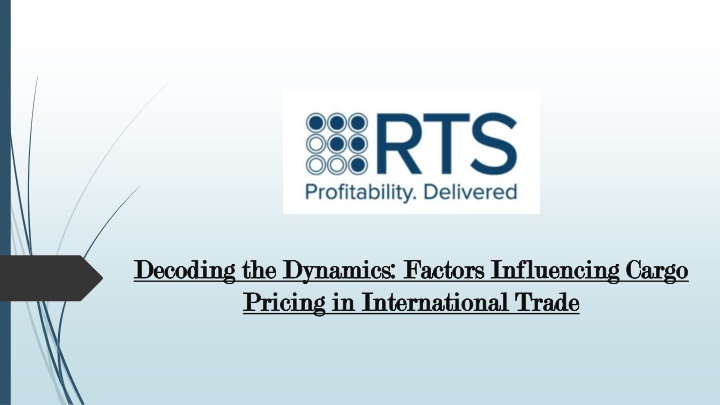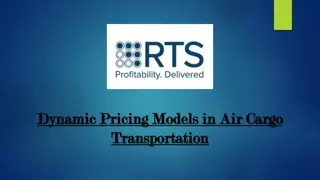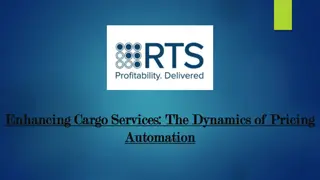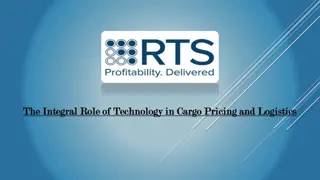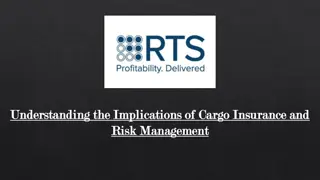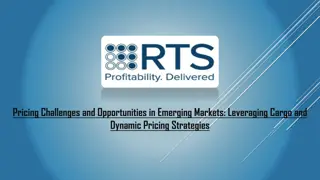Factors Influencing Cargo Pricing in International Trade
In the intricate web of global commerce, where goods traverse continents and oceans, the pricing of cargo plays a pivotal role. From determining profitability to influencing market competitiveness, cargo pricing in international trade is a multifaceted domain shaped by various factors. Revenue technology services are at the forefront of deciphering these complexities, navigating through market dynamics and industry nuances to optimize pricing strategies.
Download Presentation

Please find below an Image/Link to download the presentation.
The content on the website is provided AS IS for your information and personal use only. It may not be sold, licensed, or shared on other websites without obtaining consent from the author.If you encounter any issues during the download, it is possible that the publisher has removed the file from their server.
You are allowed to download the files provided on this website for personal or commercial use, subject to the condition that they are used lawfully. All files are the property of their respective owners.
The content on the website is provided AS IS for your information and personal use only. It may not be sold, licensed, or shared on other websites without obtaining consent from the author.
E N D
Presentation Transcript
Decoding the Dynamics: Factors Influencing Cargo Decoding the Dynamics: Factors Influencing Cargo Pricing in International Trade Pricing in International Trade
In the intricate web of global commerce, where goods traverse continents and oceans, the pricing of cargo plays a pivotal role. From determining profitability to influencing market competitiveness, cargo pricing in international trade is a multifaceted domain shaped by various factors. Revenue technology services are at the forefront of deciphering these complexities, navigating through market dynamics and industry nuances to optimize pricing strategies. Let's delve into the key factors that influence cargo pricing in international trade, shedding light on the intricate interplay of economics, logistics, and market forces. 1. 1.Market Demand and Supply Dynamics: Market Demand and Supply Dynamics:At the heart of cargo pricing lies the fundamental principle of supply and demand. Fluctuations in market demand for specific goods, coupled with the availability of shipping capacity, exert significant influence on pricing decisions. During periods of high demand or capacity constraints, prices tend to surge, reflecting the scarcity of resources. Conversely, in times of oversupply or reduced demand, prices may witness downward pressure as carriers vie for market share.
1. 1.Fuel Costs and Operational Expenses Fuel Costs and Operational Expenses: : Fuel prices constitute a substantial portion of operating expenses for cargo carriers. Volatility in oil prices can have a profound impact on transportation costs, directly influencing cargo pricing strategies. Additionally, operational expenses, including labor costs, maintenance, and regulatory compliance, contribute to the overall cost structure. Effective cost management and optimization initiatives are essential for maintaining competitive pricing in the global marketplace. 2. 2.Transportation Infrastructure and Route Economics: Transportation Infrastructure and Route Economics:The efficiency and reliability of transportation infrastructure play a critical role in determining cargo pricing. Well- developed ports, rail networks, and road systems facilitate smooth cargo movement, reducing transit times and costs. Route economics, encompassing factors such as distance, congestion, and tolls, shape pricing strategies, with carriers opting for cost-effective and efficient transport corridors to maximize profitability. 3. 3.Regulatory Compliance and Trade Policies: Regulatory Compliance and Trade Policies:Regulatory frameworks governing international trade, including customs duties, tariffs, and trade agreements, influence cargo pricing dynamics. Compliance with regulatory requirements adds administrative overheads and compliance costs, impacting pricing decisions. Changes in trade policies and geopolitical developments can introduce uncertainties, necessitating agile pricing strategies to adapt to evolving market conditions.
1. 1.Seasonality and Market Trends Seasonality and Market Trends: Seasonal fluctuations and market trends exert a significant influence on cargo pricing dynamics. Peak seasons, such as the holiday season or harvest periods, witness increased demand for certain goods, driving up prices. Similarly, shifts in consumer preferences, emerging market trends, and geopolitical events can reshape demand patterns, prompting adjustments in pricing strategies to align with market dynamics. 2. 2.Competitive Landscape and Pricing Strategies: Competitive Landscape and Pricing Strategies: The competitive landscape within the logistics industry shapes pricing strategies adopted by cargo carriers. Intense competition among carriers, freight forwarders, and logistics providers compels companies to differentiate their services while maintaining competitive pricing. Pricing transparency, value-added services, and customer segmentation strategies are employed to gain a competitive edge and capture market share. 3. 3.Technology and Innovation: Technology and Innovation: Technological advancements and innovations in logistics and supply chain management have revolutionized cargo pricing strategies. Automation, predictive analytics, and digital platforms enable real-time visibility, dynamic pricing, and optimization of supply chain operations. Leveraging technology allows companies to enhance efficiency, reduce costs, and offer tailored pricing solutions to meet customer needs.
In conclusion In conclusion, cargo pricing in international trade is a multifaceted domain shaped by a confluence of factors ranging from market dynamics and operational expenses to regulatory compliance and technological advancements. Revenue technology services play a crucial role in deciphering these complexities, enabling companies to develop agile pricing strategies that align with market trends and customer demands. By understanding and adapting to the evolving landscape of international trade, businesses can unlock opportunities for growth, efficiency, and profitability in the global marketplace.
